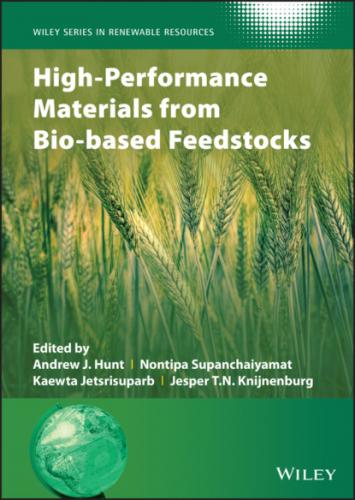2.6 Summary and Future Aspects
The exponentially growing development in the transformation of biomass into carbon‐based materials is presented in a wide variety of publications for more than a decade. Various examples related to the utilization of biomass‐derived carbon materials with applications in catalysis have been presented and discussed in this chapter. Several outstanding features of bio‐based carbon materials such as various physical properties, chemical functionalities, facile activation and functionalization, and environmental friendliness allow them to straightforwardly act as a catalyst and catalyst support. It is important to consider issues that take into account the variety and complication of agricultural biomasses utilized as raw materials in carbon synthesis. The surface area and pore diameter of carbon materials as well as surface properties including hydrophobicity, hydrophilicity, acidity, basicity, and chemical functional groups could be accommodated by the selection of the biomass and control of the preparation conditions. Biochar is a simple bio‐based carbon material commonly having diverse surface functional groups. In order to acquire a high catalytic activity and high stability of biochar, a physical or chemical modification step is required. Hydrochar also possesses a large amount of oxygen‐containing functional groups that are beneficial for the production of bio‐based chemicals and the degradation of organic pollutants. The abundance of mesopores and large surface area of activated carbon could lead to higher efficiency by providing more active sites. Novel crystalline bio‐based carbon materials including graphene and CNTs are currently focused on as high‐efficiency materials in catalysis. Even though current bio‐based carbon materials have accomplished much in catalysis applications relating to product yield, selectivity, and stability, most are not quite ready for production on an industrial scale. To accomplish a high catalytic efficiency, the production cost of biomass‐derived carbon catalysts is still higher than that of conventional catalysts. Thus, a more intensive investigation is required to decrease the production cost together with enhancing the catalytic efficiency of the bio‐based carbon materials. With the intention of moving the production and utilization of biomass‐derived carbon materials from laboratory scale to commercialization, techno‐economic and environmental feasibility should also be analyzed.
Figure 2.11 Hydrogenation of levulinic acid.
References
1 1. Grand View Research, US (2020). Catalyst Market Size & Share Analysis Report, 2019–2025.
2 2. Idrees, M., Batool, S., Kalsoom, T. et al. (2018). Animal manure‐derived biochars produced via fast pyrolysis for the removal of divalent copper from aqueous media. Journal of Environmental Management 213: 109–118. https://doi.org/10.1016/j.jenvman.2018.02.003.
3 3. Osman, N.B., Shamsuddin, N., and Uemura, Y. (2016). Activated carbon of oil palm empty fruit bunch (EFB); core and shaggy. Procedia Engineering 148: 758–764. https://doi.org/10.1016/j.proeng.2016.06.610.
4 4. Buentello‐Montoya, D., Zhang, X., Li, J. et al. (2020). Performance of biochar as a catalyst for tar steam reforming: effect of the porous structure. Applied Energy 259: 114176. https://doi.org/10.1016/j.apenergy.2019.114176.
5 5. Chen, R.X. and Wang, W.C. (2019). The production of renewable aviation fuel from waste cooking oil. Part I: Bio‐alkane conversion through hydro‐processing of oil. Renewable Energy 135: 819–835. https://doi.org/10.1016/j.renene.2018.12.048.
6 6. Dehkhoda, A.M., West, A.H., and Ellis, N. (2010). Biochar based solid acid catalyst for biodiesel production. Applied Catalysis A: General 382 (2): 197–204. https://doi.org/10.1016/j.apcata.2010.04.051.
7 7. Lee, H.W., Lee, H., Kim, Y.M. et al. (2019). Recent application of biochar on the catalytic biorefinery and environmental processes. Chinese Chemical Letters 30 (12): 2147–2150. https://doi.org/10.1016/j.cclet.2019.05.002.
8 8. Li, C., Zhang, C., Gholizadeh, M. et al. (2020). Different reaction behaviours of light or heavy density polyethylene during the pyrolysis with biochar as the catalyst. Journal of Hazardous Materials 399: 123075. https://doi.org/10.1016/j.jhazmat.2020.123075.
9 9. Nejati, B., Adami, P., Bozorg, A. et al. (2020). Catalytic pyrolysis and bio‐products upgrading derived from Chlorella vulgaris over its biochar and activated biochar‐supported Fe catalysts. Journal of Analytical and Applied Pyrolysis 152: 104799. https://doi.org/10.1016/j.jaap.2020.104799.
10 10. Kan, T., Strezov, V., and Evans, T.J. (2016). Lignocellulosic biomass pyrolysis: a review of product properties and effects of pyrolysis parameters. Renewable and Sustainable Energy Reviews 57: 1126–1140. https://doi.org/10.1016/j.rser.2015.12.185.
11 11. Byrne, C.E. and Nagle, D.C. (1997). Carbonization of wood for advanced materials applications. Carbon 35 (2): 259–266. https://doi.org/10.1016/S0008‐6223(96)00136‐4.
12 12. Volpe, M., Messineo, A., Mäkelä, M. et al. (2020). Reactivity of cellulose during hydrothermal carbonization of lignocellulosic biomass. Fuel Processing Technology 206: 106456. https://doi.org/10.1016/j.fuproc.2020.106456.
13 13. Demirbas, A. (2005). Pyrolysis of ground
